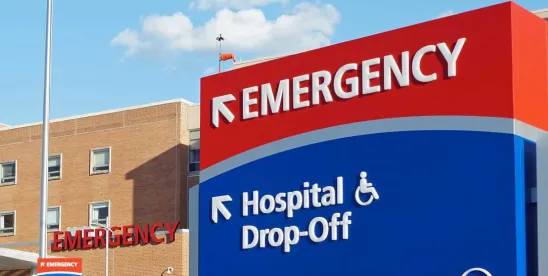Hospitals charge a standard evaluation and management services fee (“EMS”) for patients seen in the emergency room, in one of five amounts, depending upon the severity of the visit. This EMS fee is listed in the hospital’s public “chargemaster,” a comprehensive price list required by law. But does the hospital also have a duty to inform individual ER patients, before they receive services, about the EMS fee?
In a recent opinion, the California Supreme Court unanimously answered: No. A hospital’s duty is to comply with the existing state and federal pricing disclosure laws that already require public disclosure of all of a hospital’s fees, including its EMS fees. The Court’s opinion, in Capito v. San Jose Healthcare System, LP, resolves a split of authority in the Court of Appeal regarding whether a hospital can be liable under state consumer protection laws for not individually informing ER patients about EMS fees before treatment.
The Supreme Court’s decision relies heavily on the “extensive scheme of state and federal law” that “obligates hospitals to make specific disclosures about the prices of medical services.” Capito v. San Jose Healthcare Sys. LP, Case No. S280018 (Dec. 23, 2024). These laws require every hospital to publish a copy of its chargemaster—a lengthy document describing the base charge for each of its procedures and services. Cal. Health & Saf. § 1339.51(b)(1); 42 U.S.C. § 300gg-18(e); 45 C.F.R. § 180.20. The charges billed to patients is usually significantly lower than the base charges in the chargemaster due to reductions for insurance, discounts, charitable care or other reasons.
The California state agency governing health information access publishes chargemasters for free download on its website, along with other pricing disclosures. Hospitals must also publish a copy on their websites or at the hospital. Cal. Health & Saf. § 1339.51; see also 42 U.S.C. § 300gg-18(e) (similar federal law). In addition, hospitals must file with the state agency a form identifying its “top 25” most common charges—a short list typically including EMS fees. Cal. Health & Saf. § 1339.56(c).
These pricing disclosure laws reflect the Legislature’s desire to ensure consumers have access to pricing information regarding healthcare. But these are not the only policy goals expressed by the Legislature. As the Court explained, “emergency medical care is a vital public service that is necessary for the protection of the health and safety of all.” Capito at 2 (quoting in part Stats. 1987, ch. 1240, § 1, p. 4406). To protect public health, state and federal law require hospital with public emergency rooms to provide care to any person who needs life-saving treatment or has a serious injury or illness. Cal. Health & Saf. § 1317(a); 42 U.S.C. § 1395dd (EMTALA). Emergency care must be provided regardless of the patient’s ability to pay. H&S § 1317(b); see 42 U.S.C. § 1395dd(h); 42 C.F.R. § 489.24(a)(1). This means the hospital may not question the patient about payment until after the patient is stabilized. Id. Federal law also forbids hospitals from “unduly discourag[ing]” patients from getting treatment through its registration procedures. 42 C.F.R. § 489.24(d)(4)(iv).
California law also requires hospitals to provide ER patients with a written agreement requiring the patient to pay for services after receiving treatment. Cal. Health & Saf. § 1317(d).
The plaintiff in Capito visited the ER at San Jose Regional Medical Center twice, each time signing the hospital’s admissions agreement, in which she agreed to financial responsibility. She was billed for a “Level 4” EMS fee after each visit. There was no dispute that the hospital’s EMS fees were included on its chargemaster, which was properly submitted to the state regulator and published on its website. Nonetheless, Capito argued on behalf of a putative class of ER patients that the hospital owed a duty under California’s Unfair Competition Law (“UCL”) and the Consumer Legal Remedies Act (“CLRA”) to specifically inform her about the EMS fee when she arrived at the ER, before receiving treatment.
Capito’s allegation is virtually identical to a string of other putative class actions filed against hospitals throughout California. Most courts rejected plaintiffs’ non-disclosure theory regarding EMS fees. As the cases percolated through the court system, published and unpublished cases emerged rejecting the theory—mostly based on the extensive statutory disclosure laws. See Gray v. Dignity Health, 70 Cal. App. 5th 225 (1st Dist. 2021); Saini v. Sutter Health, 80 Cal. App. 5th 1054 (1st Dist. 2022); Moran v. Prime Healthcare Management, 94 Cal. App. 5th 166, 169-70 (4th Dist. 2023) (review granted); Yebba v. Ahmc Healthcare, 2021 Cal. App. Unpub. LEXIS 4237 (4th Dist. 2021). But a few courts agreed the patients could state a claim based on non-disclosure of an EMS fee. See Naranjo v. Doctors Medical Center of Modesto, Inc., 90 Cal. App. 5th 1193 (5th Dist. 2023); Torres v. Adventist Health System/West, 77 Cal. App. 5th 500 (5th Dist. 2022).
The Supreme Court’s Capito decision resolves this conflict in favor of hospitals—holding that neither the UCL nor the CLRA requires an additional disclosure of EMS fees beyond what the regulatory scheme already demands. Requiring additional disclosures would “alter the careful balance of competing interests” already reflected in the “multifaceted scheme developed by state and federal authorities.” Capito, __ Cal. __ at 2. The Court also noted that California law requires hospitals to provide price estimates for uninsured patients in some circumstances, but the law specifically exempts emergency rooms from this requirement—further evidencing deliberative Legislative balancing.
The Supreme Court also rejected Capito’s key argument for liability under the CLRA—that the hospital had “exclusive knowledge” the EMS fees. Capito argued disclosure of EMS fees on the chargemaster was insufficient because the chargemaster is “tens of thousands” of lines long and uses various abbreviations and codes. Again, the Court disagreed. It viewed the disclosure of EMS fees in the chargemaster as sufficiently clear. The Court also found it “notable” that the EMS fees were listed on the shorter “top 25” list of most common procedures.
The Supreme Court’s Capito decision puts a significant damper on the string of class actions based on ER fees or similar pricing issues. While the Capito decision focuses on UCL and CLRA claims based on a non-disclosure theory, the Court’s decision may also limit contract-related theories raised by plaintiffs in similar cases. The contract theory posits that EMS fees are intended to cover hospital administrative costs and overhead, and are not actually “services rendered” to the patient, so the hospital supposedly cannot lawfully bill them under the admissions agreement with the patient. See Salami v. Los Robles Reg’l Med. Ctr., 324 Cal. Rptr. 3d 45 (2024). The Capito decision debunks this theory in dicta by explaining that EMS fees reflect medical services, such as reviewing tests, ordering medications, conferring with staff and other medical decision-making.
Capito will leave a large mark on pricing lawsuits in the healthcare field. Its limitations on non-disclosure and contract theories may motivate class action plaintiffs to re-focus on unconscionability theories. But unconscionability raises difficult-to-overcome problems for plaintiffs at the class certification stage, given each patient’s unique medical and financial circumstances. The Court’s decision in Capito that hospitals have no extra duty to inform patients of ER fees will presumably also resolve two related EMS fee cases where the Court had granted review pending resolution of Capito. See Moran, 94 Cal. App. 5th 166 (2023); Naranjo v. Doctors Med. Ctr. of Modesto, 90 Cal. App. 5th 1193 (2023).



 />i
/>i

